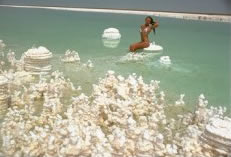|
||||||
Attractions and Cities
Jerusalem
They don't come any holier than this. Jews, Muslims, Christians: all three hold Jerusalem sacred, and it seems all three would rather see it destroyed than have the others touch it. Of course, most people come to Jerusalem to immerse themselves in this holy history, but try to remember that Jerusalem is as much a modern city as a concept, as full of living, breathing people as ghosts and Biblical figures. The city is divided into three parts: the walled Old City, where most of the sights are; the predominantly Arab East Jerusalem; and the rapidly expanding new city, known as West Jerusalem. The Old City is also divided, into Armenian, Christian, Jewish and Muslim quarters.
|
|
||
|
To get an idea of the Old City, it's worth strolling around the city walls, built in the 16th century by Suleyman the Magnificent. Rising over the city is the Haram-ash Sharif/Temple Mount, centrepiece for all the squabbles. This is where Mohammed rose to heaven and where God instructed Abraham to sacrifice his son. The magnificent Dome of the Rock mosque dominates the Mount, with the Al-Aqsa Mosque and Islamic Museum a little to its south. The Western Wall, at the base of the mount, is the most accessible of the four walls of the Second Temple, built by King Herod. This accessibility has made it a popular place for Jewish worship. To complete the holy sites trilogy, pop over to the Christian Quarter for a visit to the Church of the Holy Sepulchre. This church is built over the site where Jesus was (probably) crucified, buried and resurrected - its appeal relies on its historical links rather than its architectural splendour. Most people arrive here after walking down the Via Dolorosa, the route Jesus followed as he carried his cross.
If you've had enough religion, head out of the Old City to bustling, fume-hazed, Palestinian East Jerusalem, or the cafes and shopping centres of New Jerusalem. To the west of the city you'll find Yad Vashem, the moving and disturbing Jewish memorial to the holocaust. To the east is the Mount of Olives, where Jesus ascended to heaven and where more earthbound folk can get a beautiful view of the city.
Where you stay in Jerusalem really depends on what you want out of your visit. The Old City and East Jerusalem have the cheapest places and the best atmosphere, and they're closest to the sights. On the downside, it's a long walk to the cafes and nightlife of the New City, and the Old City pretty much shuts down after dark. If you're prepared to pay more, and if living it up is your priority, head for the New City. For really good, really cheap food, try the Mahane Yehuda market to the west of the Old City. The best places for felafel are below the city walls in East Jerusalem, or in the shopping precincts of the New City.
Tel Aviv
Less than a century old, Tel Aviv is about finance, business and fun - it's pretty hard to compete with Jerusalem's three millennia of history, so Tel Aviv doesn't even try. Nearly everyone who lives here came from somewhere else, and a short walk through the city will take you to the spicy orientalism of the Yemenite Quarter, the seedy vodka cafes of Allenby St and the Miami chic of pastel pink beachfront condos. Tel Aviv isn't big on sights, but if you've been to Jerusalem you've probably had a gutful anyway. If you just can't get enough, visit the Diaspora Museum, which chronicles Jewish culture in exile, or the Tel Aviv Museum of Art. When you've finished, wander through the markets of the Yemenite Quarter, stop for a cappuccino and then pull up some sand on one of the best beaches in the Middle East.
The Galilee
Serious Bible territory, this is where Jesus did most of his preaching as well as a spot of water walking and some fish multiplying. It's also Israel's lushest region, with green valleys, verdant forests, fertile farmland and the Sea of Galilee. Nazareth, Jesus' childhood home, is a popular destination for pilgrims, but not much chop for the casual visitor. Although there are some important churches here, such as the Basilica of the Annunciation where the Angel Gabriel appeared to Mary, the town itself is pretty ugly. Tiberias, on the western shore of Lake Galilee, is a much better base for enjoying the area. Spend the day enriching your soul at the tombs of ancient sages, then soak away the pains of the body in the town's famous hot springs. The Galilee is also home to the country's most extensive archaeological site, Beit She'an. The site is still being excavated, but a beautifully-preserved Roman amphitheatre, Byzantine baths, a temple and a colonnaded Roman street have already been uncovered. The site is on the Tiberias-Jerusalem bus route.
Bethlehem
Bethlehem is a cynic's delight, with Manger Square, Manger St, Star St, Shepherds' St, two Shepherds' Fields and an unheavenly host of 'Christmases', but if you've got even the remotest Christian background, you're bound to wind up here. Bethlehem is built around Manger Square, the town centre and, strangely, the town carpark. The Church of the Nativity is the raison d'être of this holy town, and one of the world's oldest working churches. Built over the spot where Jesus is said to have been born, it's a suitably august and venerable piece of architecture. If kitsch is more to your taste, take a look at Milk Grotto Chapel, a shrine to the Virgin Mary's lactations. Rachel's Tomb, on the edge of town, is one of Judaism's most sacred shrines, and is also revered by Muslims and Christians. There's not much accommodation in Bethlehem, but it's only a 40-minute bus ride from Jerusalem. |
|||


